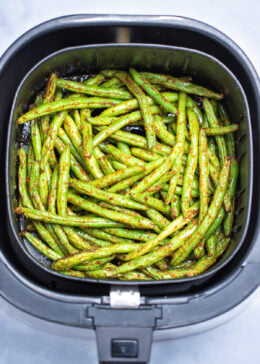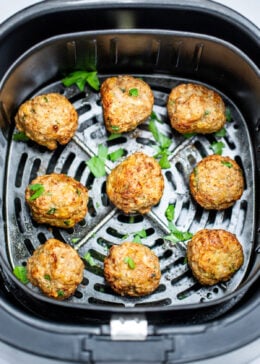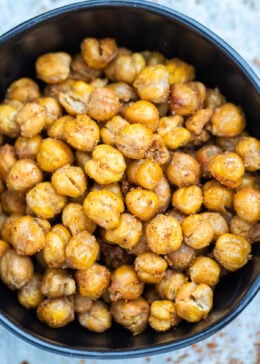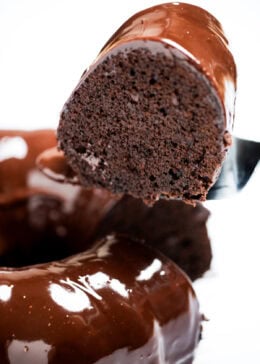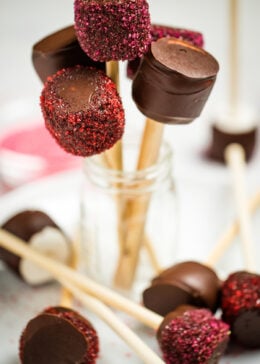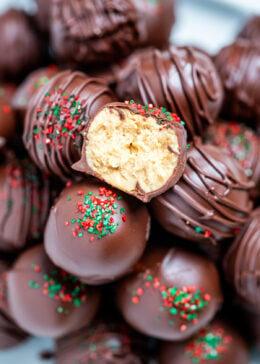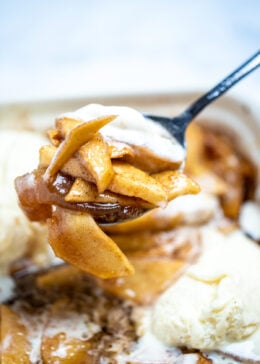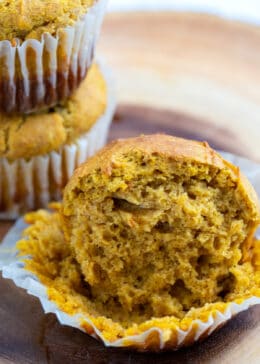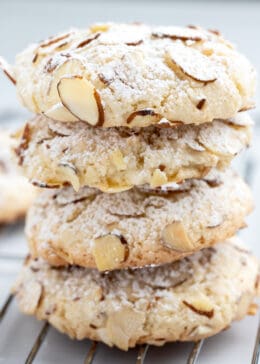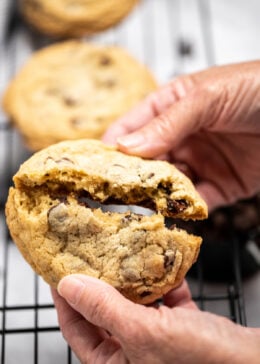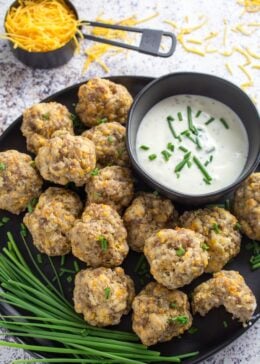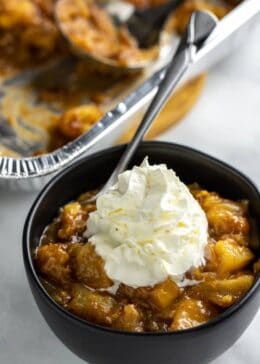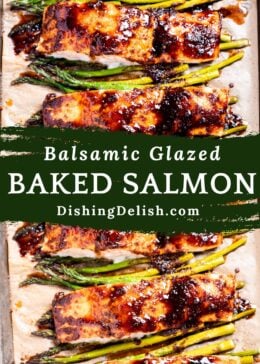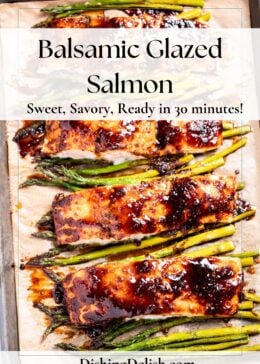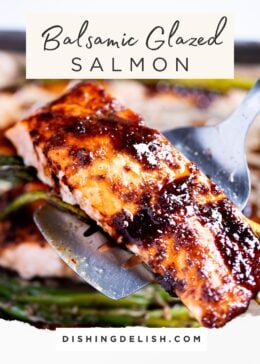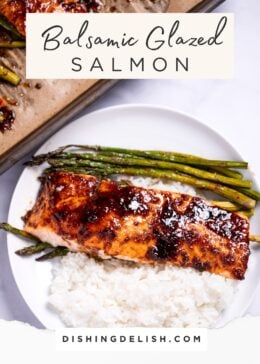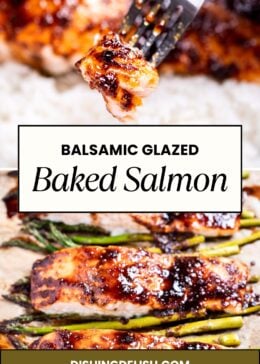Balsamic Glazed Salmon
Balsamic Glazed Salmon is sweet and savory, made with tender salmon fillets baked in a balsamic reduction, ready in under 45 minutes!
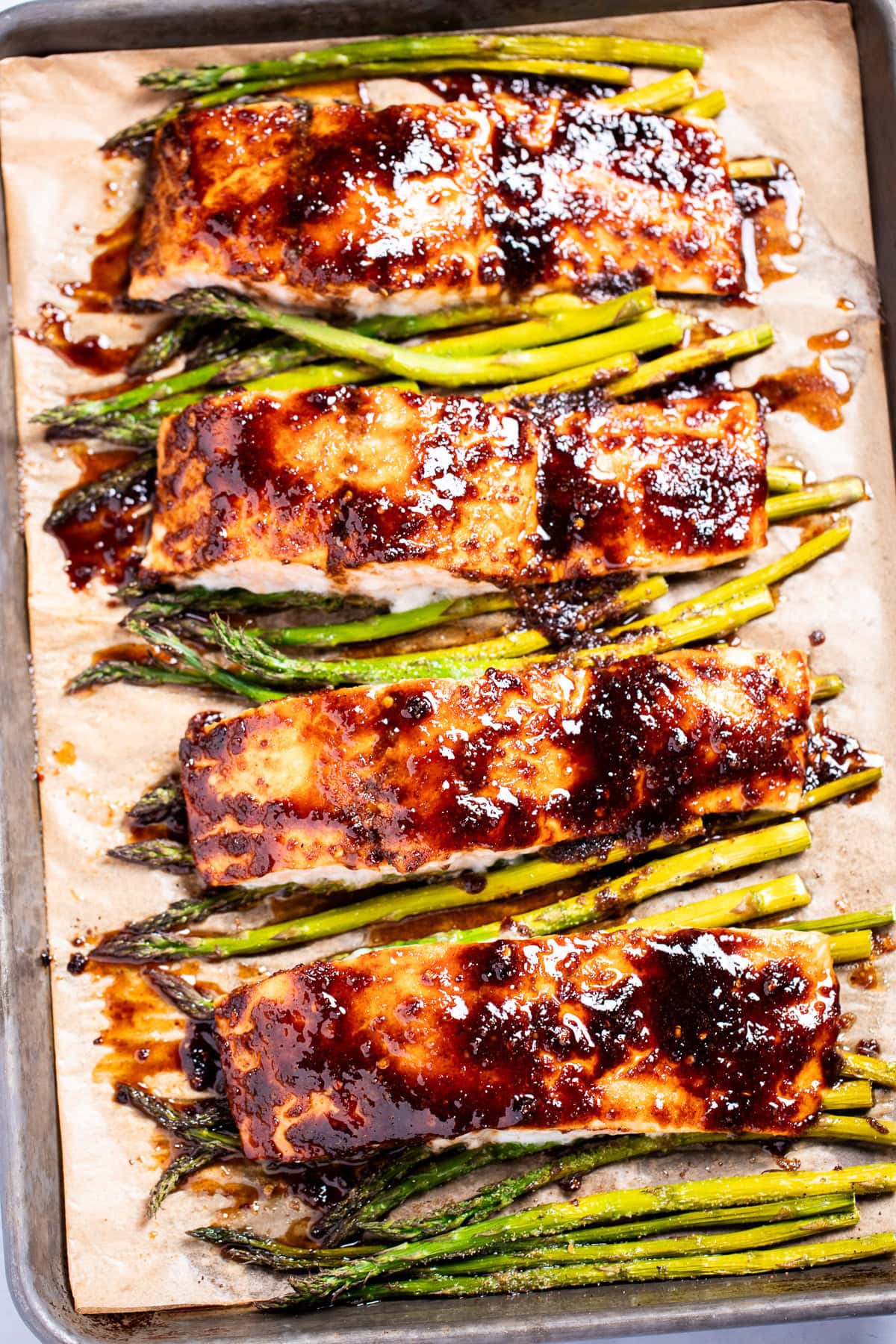
Balsamic Glazed Salmon is a great recipe to make for a quick weeknight meal that tastes like something you’d order at a restaurant in a coastal town. It takes about 30-40 minutes to make, and is really easy to throw together, including the homemade balsamic vinegar reduction!
I know a balsamic reduction can sound impressive, but honestly it’s just simmering and stirring the sauce until it looks thicker. That’s it! This is also a great recipe for meal planning, because it goes great on a salad for a balanced meal.
If you loved this recipe, you may also love my Lemon Butter Baked Cod, or my Parmesan Crusted Tilapia!
Table of contents
Why You’ll Love This Recipe
Easy to Make – With just a handful of pantry ingredients, you can have dinner ready in less than 45 minutes! All you need to know how to do is simmer, stir, and put everything on a sheet pan.
Pairs with Simple Sides – This recipe goes really well with simple side dishes, because it’s the star of the show! Pair this with rice, mashed potatoes, or steamed veggies.
Incredible Flavor – Tangy balsamic vinegar with sweet brown sugar and dijon mustard come together in a rich caramelized glaze, paired with the buttery flavor and texture of the salmon fillets.
Ingredients You’ll Need
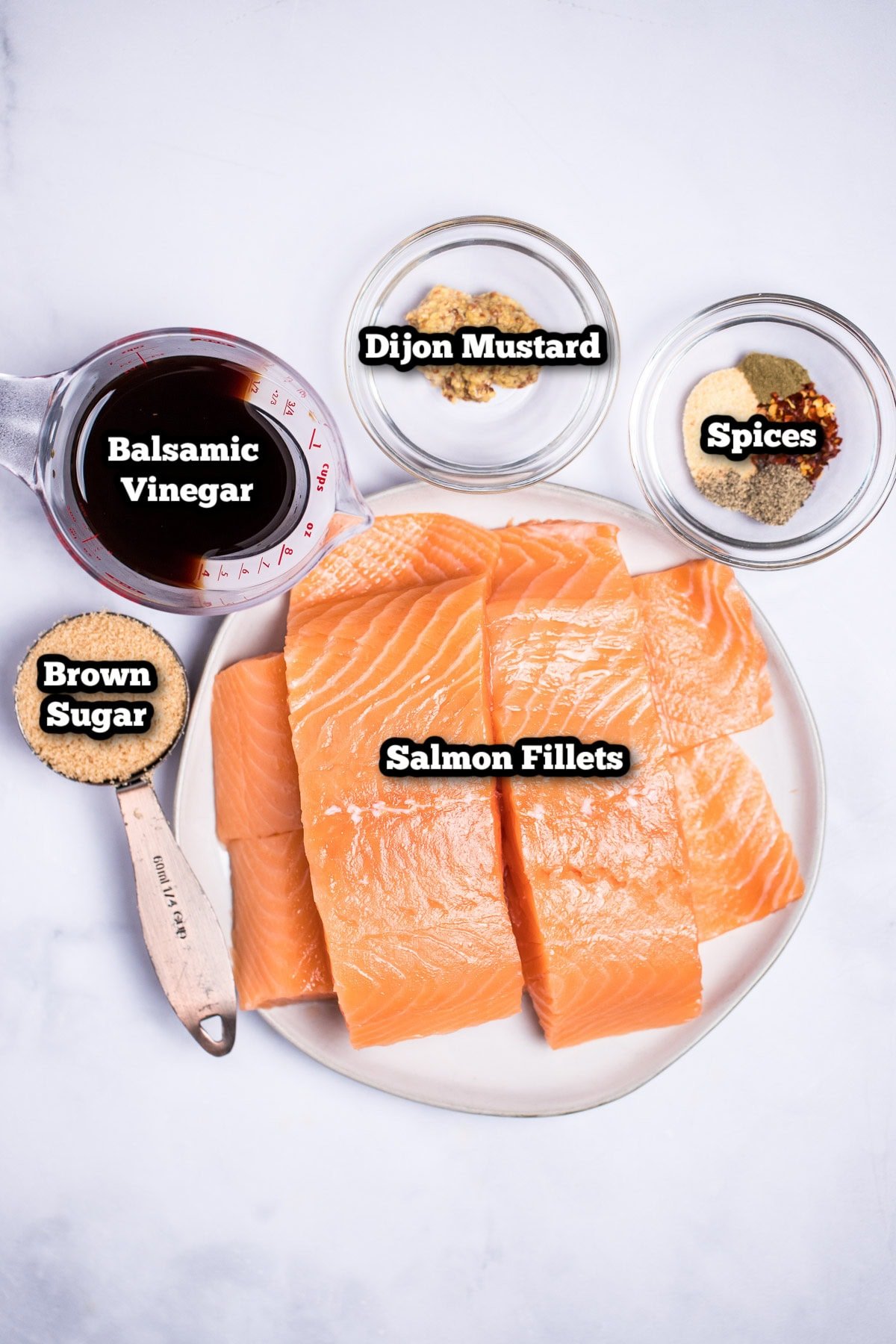
Salmon Filets. Salmon has a naturally rich and buttery flavor that pairs perfectly with the sweet and tangy balsamic glaze. I like to use 4-5 ounce fillets with this recipe, but you can make extra balsamic glaze (double it and increase the reduction time) and make a whole piece of salmon instead.
When you’re picking out some salmon, remember that it should have a light aroma like the sea, and not smell “fishy”.
Light Brown Sugar. This adds a really nice molasses note to the glaze, bringing a much deeper flavor profile to the whole dish.
It also balances the acidity of the vinegar with a rich, caramelized sweetness.
Balsamic Vinegar. This provides a lot of tangy flavor and slight sweetness, giving that nice dark caramelized color to the fish.
Dijon Mustard. This helps round out the flavor profile, and helps emulsify the reduction, holding everything together nicely, and coats the salmon evenly. You can also use stone ground mustard.
Spices. I’m adding some simple pantry spices for flavor. Just same garlic powder, ground thyme, red pepper flakes, kosher salt, and black pepper.
If you want to infuse even more flavor into the sauce, you can add a little extra virgin olive oil and fresh minced garlic to the pan and cook for about a minute before adding the other glaze ingredients. Just a touch of olive oil to keep the garlic from sticking.
Parsley. I like to top this dish with some fresh herbs, both for flavor and presentation, but this part is totally optional. You can also use green onion or fresh dill.
Kitchen Tools
For this recipe, you’ll need a medium saucepan, and a sheet pan.
How to Make Balsamic Glazed Salmon
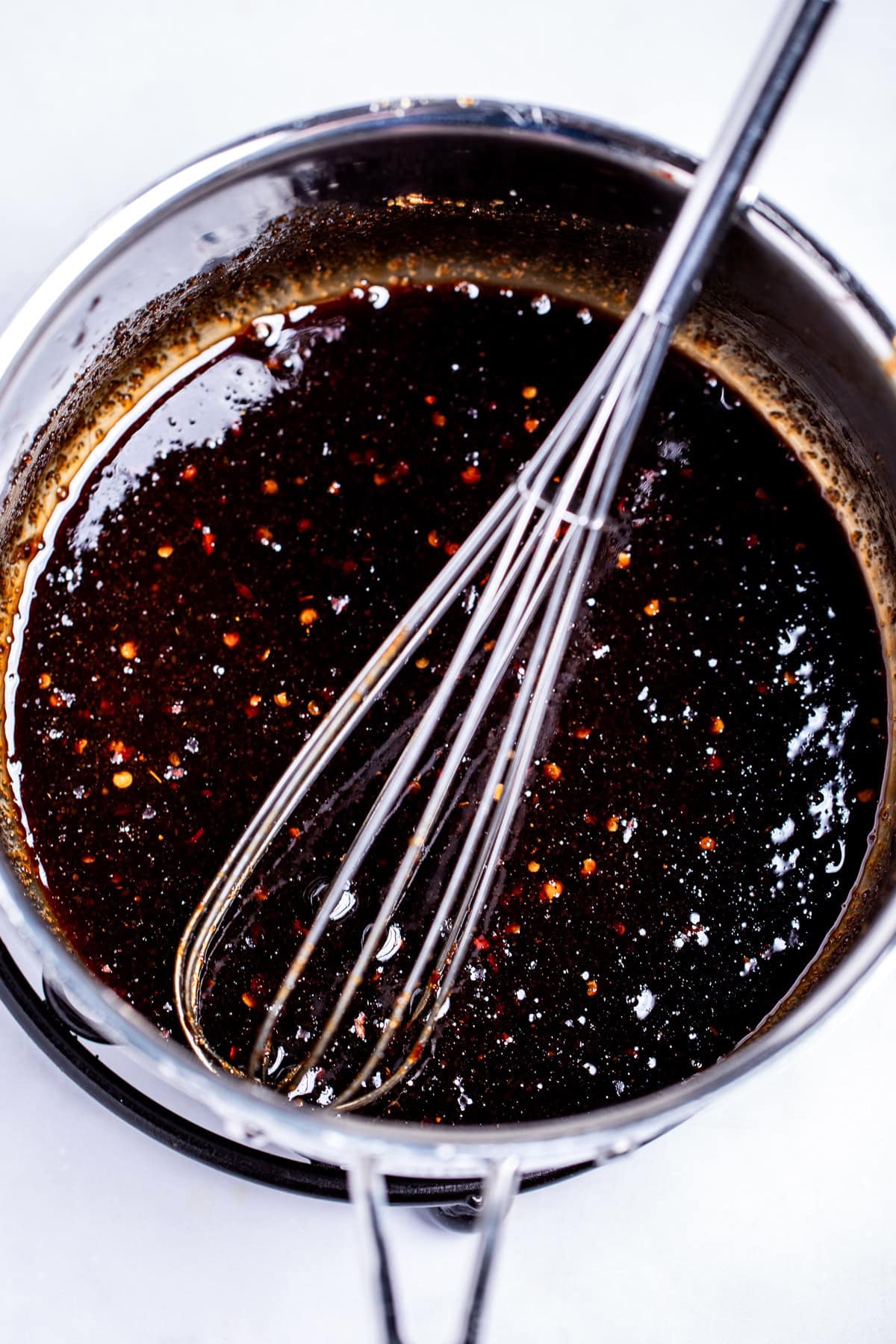
Preheat the oven to 400°F. Line a baking sheet with parchment paper and set aside.
Over medium heat, add all of the ingredients for the balsamic glaze to the saucepan and whisk together until combined.
Bring it to a boil, then reduce the heat to a simmer, stirring constantly. The glaze is ready when it reduces by about half and coats the back of a spoon, about 15 minutes.
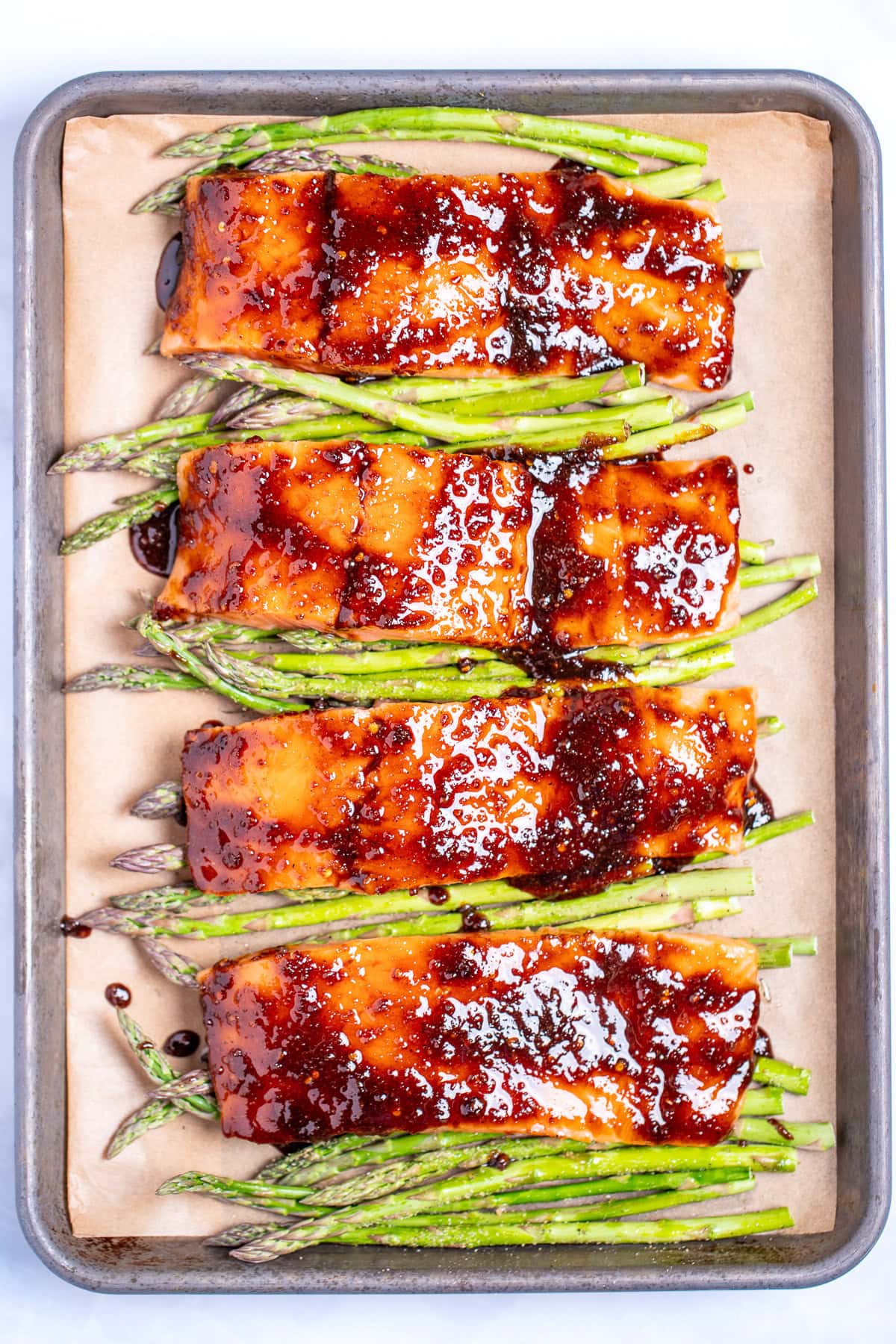
Place the salmon fillets on the baking sheet, leaving some space between each one.
Pat them dry with a paper towel and sprinkle with salt and pepper before pouring the glaze evenly over each piece.
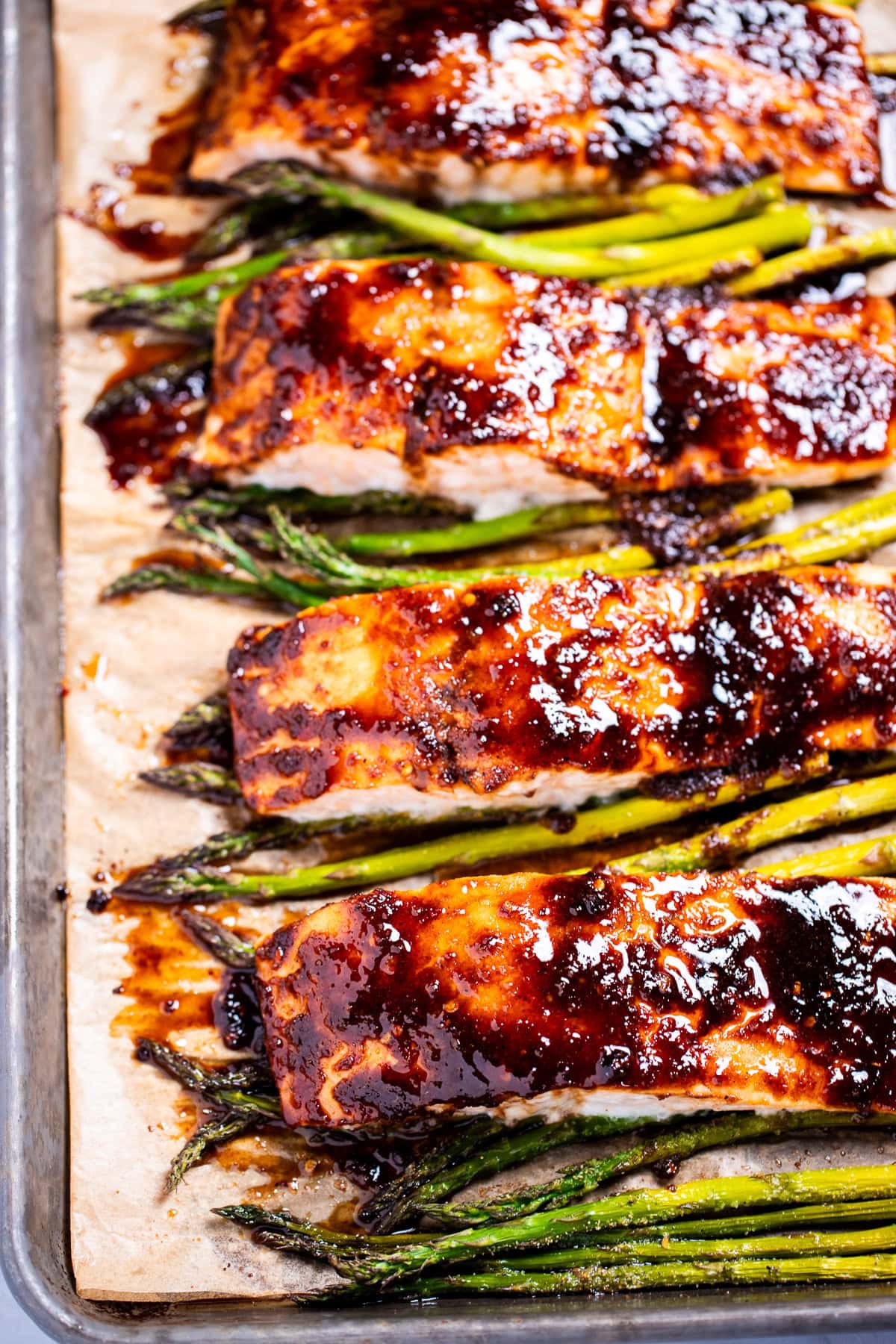
Bake for 15-20 minutes, or until the salmon is fully cooked through and reaches in internal temperature of 145°F in the middle (per the USDA guidelines).
Recipe Variations
- You can replace the brown sugar for honey or maple syrup in this recipe. These options will change the flavor slightly, but in a good way.
- Make this more spicy with a pinch of cayenne pepper or hot sauce in the glaze. Or add a little smoky depth with a dash of paprika.
- Make a little extra glaze and make some roasted balsamic brussel sprouts to go with the salmon!
- If you have faster cooking veggies like asparagus or broccoli, you can place the salmon on top of the veggies.
Recipe Tip! When picking out your salmon fillets, look for center cuts that are all about the same size, so they finish cooking at the same rate.
Frequently Asked Questions
You could do it either way, but covering the salmon typically causes it to steam instead of roasting. For recipes that have a darker glaze, where you’re looking for that really rich color at the end, I recommend cooking it uncovered for the entire time.
Recipe Tip! Not all balsamic vinegar can be treated equally! Aged balsamic vinegar (the label will tell you if it is aged) will have a sweeter profile, with the cheaper versions being a little more acidic. You can balance this out by adding more sugar as-needed.
More Seafood Recipes
- Crab and Corn Chowder
- Air Fryer Tilapia
- Gluten Free Crab Cakes
- Cream Cheese Shrimp Dip
- Low Country Shrimp Boil
Storage
Refrigerate balsamic glazed salmon in an airtight container for 2-3 days.
Freeze leftover salmon in a freezer-safe container for 2-3 months.
Cooking Tips
- When making the glaze, don’t lean over and smell it. The steam will be very acidic and won’t be pleasant!
- If you’re in a rush, you can make half of the balsamic glaze, which will be much faster to cook in the saucepan.
- Wild caught salmon can be leaner, and may cook a little faster. Farm raised salmon will have a richer flavor, and will take slightly longer to cook.
- Make sure to quickly reduce the glaze to a simmer over medium-low heat. If you boil it too much, the glaze can turn bitter or lumpy.
- Check the salmon at the 15 minute mark, and add an additional 5 minutes as-needed.
- If you want a really nice caramelized top, you can also broil the salmon at the end for 1-2 minutes. Watch it really closely, because broiling can burn things very quickly.
- According to the USDA guidelines, the salmon is cooked through when it reaches in internal temperature of 145°F.
- Serve this with leafy greens, rice, or mashed potatoes. For the last few days of summer, this also pairs well with my Kale & Quinoa Salad, fennel salad or fresh pasta salad (use the salmon instead of tuna in that recipe), and some nonstarchy vegetables for a complete meal.
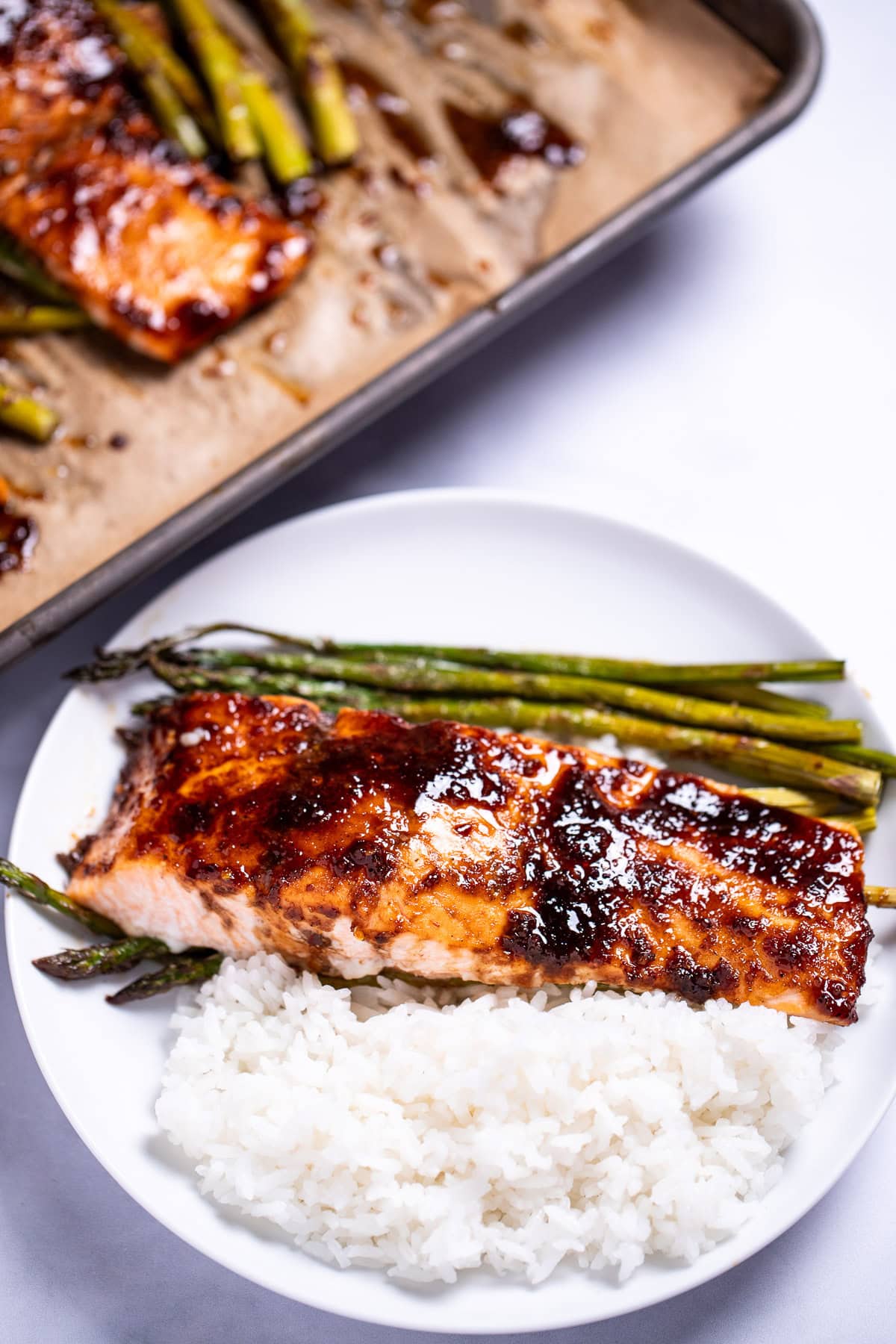
Tried this recipe? ⭐ Leave a review and share what worked best for you—your tips help other home cooks get the same delicious results!
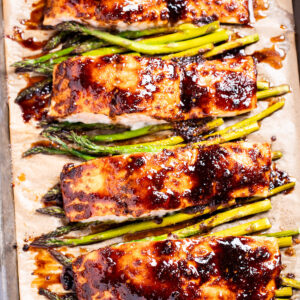
Balsamic Glazed Salmon
Ingredients
- 4 medium salmon fillets, (about 5 ounces each)
- 1/4 teaspoon kosher salt, or to taste
- 1/4 teaspoon black pepper, or to taste
For the Balsamic Glaze
- 1/4 cup light brown sugar
- 1/2 cup balsamic vinegar
- 1 tablespoon Dijon mustard
- 1 teaspoon garlic powder
- 1/4 teaspoon ground thyme
- 1/2 teaspoon red pepper flakes, optional
Equipment
- 1 medium saucepan
- 1 Sheet pan with parchment paper
Instructions
- Preheat the oven to 400°F. Line a baking sheet with parchment paper and set aside.
- Over medium heat, add all of the ingredients for the balsamic glaze to the saucepan and whisk together until combined. Bring it to a boil, then reduce the heat to a simmer, stirring constantly. The glaze is ready when it reduces by about half and coats the back of a spoon, about 15-20 minutes.
- Place the salmon fillets on the baking sheet, leaving some space between each one. Pat them dry with a paper towel and sprinkle with salt and pepper before pouring the glaze evenly over each piece.
- Bake for 15-20 minutes, or until the salmon is fully cooked through. Top with fresh parsley and serve.
Notes
- When making the glaze, don’t lean over and smell it. The steam will be very acidic and won’t be pleasant!
- Wild caught salmon can be leaner, and may cook a little faster. Farm raised salmon will have a richer flavor, and will take slightly longer to cook.
- When picking out your salmon fillets, look for center cuts that are all about the same size, so they finish cooking at the same rate.
- Make sure to quickly reduce the glaze to a simmer over low heat. If you boil it too much, the glaze can turn bitter or lumpy.
- Check the salmon at the 15 minute mark, and add an additional 5 minutes as-needed.
- If you want a really nice caramelized top, you can also broil the salmon at the end for 1-2 minutes. Watch it really closely, because broiling can burn things very quickly.
Nutrition
We are a participant in both the RewardStyle and Amazon Services LLC Associates Program, which are affiliate advertising programs designed to provide a means for sites to earn advertising fees by advertising and linking to amazon.com and through RewardStyle.


